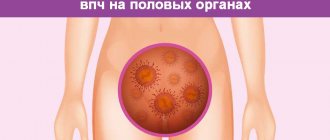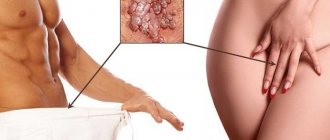If you suddenly have red pimples on the head of the penis, this is a cause for concern.
The most important thing in this situation is not to engage in traditional treatment or self-medication, but to immediately contact a specialist.
Any delay is an additional bonus that you give to the infection.
And we are talking not only about your health, but also about the health of loved ones, relatives and even the health of the unborn baby.
Blisters on the penis due to candidiasis
Blisters on the penis after sex may be due to another sexually transmitted infection.
Candida fungus can provoke an inflammatory reaction.
The first symptoms appear a few days after infection.
The risk of their occurrence is higher if:
- weak immunity;
- diabetes mellitus;
- violation of personal hygiene;
- sweating
Taking antibacterial agents initiates or aggravates the course of urogenital candidiasis.
Spots, papules, and sometimes ulcers appear on the skin of the penis.
Most often the head and foreskin become inflamed.
The infection can also spread to the groin folds.
It is characterized by redness, white deposits, a sour odor, and severe swelling of the inflamed organs.
Why do rashes appear?
The occurrence of rashes on the genitals of a man can be associated with the influence of a variety of factors. As a rule, such a symptom indicates some kind of health problem - dermatological or venereological diseases. The most common cause of rashes is:
- Local allergic reaction.
- Fungal diseases.
- Some sexually transmitted diseases.
- Various types of dermatitis, including infectious.
Only a qualified specialist - a dermatologist or urologist - can determine the type and cause of rashes on the penis. Self-diagnosis and self-medication are fraught with serious health problems.
Is there an allergy to the genital organ?
An allergic reaction can manifest itself in different parts of the body, but its isolated occurrence on the genitals usually occurs due to local contact with allergens, which may include:
- Detergents, including components of washing powder in underwear.
- Synthetic underwear (in this situation, the rash may appear soon after putting on a new pair of underwear for the first time).
- Contraceptive products (both condoms and specific female products - spermicidal gels, etc.).
- Medicines for local application. An allergic reaction may occur during treatment of other health problems or prevention of STDs using antiseptics, etc.
It is extremely rare that isolated genital allergy is a consequence of oral ingestion of allergens. This reaction can be caused by antibacterial drugs, vitamins, vaccines, etc. But most often, rashes in this case also appear on other parts of the body.
It is quite difficult to distinguish penile allergies from other possible disorders. This condition usually makes itself felt:
- Rashes. Most often they look like red spots or blisters, similar to a nettle burn. In the latter case, doctors talk about the development of urticaria.
- Noticeable itching and burning.
- Peeling on the skin of the penis.
- Swelling of the mucous membranes, which is accompanied by noticeable redness.
Quite rarely, the cause of an allergy to the penis is contact with female vaginal secretions. Only a doctor can find out what causes the unpleasant symptoms.
Small red dots
Sometimes the reason for the appearance of a small red rash is quite commonplace. Such rashes on the penis can appear due to microtraumas - during sexual intercourse or due to friction with too tight underwear or clothes with rough seams. A small red rash can be found on the genitals after intense cycling in inappropriate clothing or after riding. This symptom is usually not accompanied by any other health problems, although severe trauma can cause discomfort and pain. But the disorder occurs without itching.
READ ALSO: Strategy for choosing external therapy for microbial eczema
Small red rashes that are accompanied by itching can also be a consequence of poor hygiene. If you ignore this symptom and do not normalize the care of the genital organs, inflammation of the glans penis and other unpleasant conditions may develop.
The appearance of small red rashes on the head of the penis may be due to irritation of the delicate skin by abnormal discharge from the urethra. Usually in such a situation the patient also experiences discomfort and itching, including during urination.
White on foreskin
The appearance of white rashes on the penis may be due to:
- Development of candidiasis (thrush). In this case, areas of white curd coating may be found on the mucous membranes and foreskin, and if you try to remove them, an inflamed and possibly bleeding mucosa will be revealed underneath. Candidiasis can also manifest itself as severe itching, discomfort during urination and sexual intercourse. Its development is associated with infection with Candida fungi, as well as with a severe decline in immunity.
- Pyoderma. This is a bacterial disease in which single or multiple pustules (pimples with a white head) may appear on the skin of the penis and foreskin. The skin around them usually remains unchanged, but may become inflamed and red. The development of pyoderma may be associated with excessive sweating, insufficient hygiene, decreased immunity and other similar factors.
Sometimes men mistake small wen on the skin for a white rash, which does not cause any discomfort. Such neoplasms most often occur in adolescents during hormonal fluctuations in the body and do not pose a threat to health.
What is this flesh color?
New growths that look like a rash, but are flesh-colored, may well appear on the penis. This is how it can manifest itself:
- Human papillomavirus (HPV). This is a very common disease that can be contracted during sexual intercourse, through direct contact and in everyday life. The virus sometimes does not manifest itself in any way, but with a decrease in immunity it can cause the formation of papillomas on the penis, scrotum, and also in the anorectal area (near the anus). Such neoplasms initially look like fleshy pimples, but later become small papillary tumors. They do not cause any discomfort, but require mandatory treatment. Papillomas can lead to cancer.
- Pearly papules. These are absolutely safe neoplasms that have a cone shape and are localized exclusively on the crown of the head of the penis. Papules are not a source of infection, cause absolutely no discomfort and cannot harm health, so they are not treated.
It would be a good idea to show the skin-colored elements of the rash to a doctor. A specialist will be able to easily differentiate natural formations from pathological ones.
After intercourse
If a rash appears on the skin or mucous membranes of the penis shortly after sexual intercourse, most men immediately begin to suspect infection with sexually transmitted infections. But in fact, such diseases do not make themselves felt immediately after sex, but several days or even weeks later. If rashes appear on the first day after sexual intercourse, most likely their occurrence is associated with allergies or microtraumas of the penis. But if elements of the rash appear over time, they may be a sign of:
- Gonorrhea and chlamydia. In such diseases, the rash appears due to irritation of the penis by abnormal discharge from the urethra. Additionally, the patient may be bothered by itching and burning of the head of the penis, as well as the specific discharge itself. Sometimes there is pain when urinating.
- Syphilis. At the site of the introduction of Treponema pallidum (the causative agent of syphilis), a single element of the rash appears - a chancre, in the center of which erosion subsequently forms. This area does not cause pain or discomfort, and it does not lead to inflammation of the surrounding skin. In the middle part of the chancre there is a dense coating of yellow or gray color. Its diameter reaches 1-2 cm. At the same time, the patient may be concerned about a general deterioration in health, increased temperature and aches. Secondary syphilis can also manifest itself as rashes on the penis; the rash occurs after the chancre has successfully disappeared in the absence of targeted treatment. It looks like pale pink or red elements that do not cause discomfort and do not disappear for a long time.
If there is a suspicion that the rash on the penis is associated with sexual intercourse, it is better to play it safe and consult a urologist or venereologist. A dermatologist can also make a preliminary diagnosis.
Blisters and itching
The appearance of vesicular rashes on the penis most likely indicates the occurrence of genital herpes. This is a viral disease, infection of which can occur through bodily contact with a sick person, most often during genital, oral or anal intercourse. Self-infection is also possible, in which pathogens are transferred from the lip (the typical site of localization of the herpes simplex virus) to the genitals. The characteristic manifestations of genital herpes are blistering-like rashes that:
- Appear in the genital area. Sometimes the rash appears on the skin of the thighs and near the anus.
- They are very itchy and cause a burning sensation.
- They burst over time, leaving behind painful ulcers. They subsequently heal, becoming covered with a crust.
READ ALSO: Stye on the eye - contagious or not - ONLINE HOSPITAL
With the development of genital herpes, general well-being usually also suffers. The patient may be bothered by aches in muscles and bones, weakness, and a slight increase in temperature.
Genital herpes is dangerous because its pathogen is never completely eliminated from the body. The disease can recur at any time due to decreased immunity.
Other reasons
Possible causes of a rash on the penis include:
- Psoriasis. This is a chronic dermatological disease that can sometimes appear on the genitals. It is typically characterized by the appearance of pinkish or flesh-colored flaky plaques on the skin and mucous membranes, which have clear contours. When localized on the head of the penis, the disease can manifest itself as smooth itchy spots. It is simply impossible to cure psoriasis completely; all treatment measures can only reduce its manifestations.
- Scabies. This is a parasitic disease caused by the scabies mite. You can become infected with it through prolonged contact with a sick person - skin to skin. Scabies is manifested by severe itching, rashes of various types, initially red nodules and blisters, but later pustular elements and crusts may be observed. This disease is characterized by the presence of scabies - lines of whitish-gray color, ranging in size from 1 mm to 1 cm with a dark dot at the anterior end. Symptoms of the disease often first appear on the penis; they can also be observed in the spaces between the fingers and on the wrists.
- Cancer diseases. Single pimples and ulcers on the penis that do not heal for a long time may be signs of cancer.
READ ALSO: Baziron AC for acne and blackheads on the face, reviews
Several pimples on the penis may well be marks from insect bites, such as mosquitoes.
Condylomas on the penis
Sometimes blisters under the head of the penis are called condylomas.
These are growths of the papillary layer of the dermis (vegetation), which are formed as a result of infection with the papilloma virus.
This virus is transmitted sexually.
True, not everyone develops clinical signs of the disease.
The risk is higher in people with weak immune systems.
Symptoms appear six months, and sometimes even a year after infection.
In the classic version, condylomas are protrusions on a thin stalk.
They are red or pink in color and rich in blood vessels.
Less common are flat or inverted condylomas.
Usually these formations do not reach large sizes.
If a person has a large blister on his penis due to a human papillomavirus infection, it can be easily removed.
For this, a laser, radio wave method or liquid nitrogen is used.
With a large number of condylomas, immunomodulatory therapy is required to eliminate the virus from the body.
Blisters on the penis due to allergies
Another cause of blisters on the penis may be allergic dermatitis.
It is a delayed-type hypersensitivity reaction.
This disease is characterized by the alternating appearance of areas of skin redness, papules, transparent blisters on the penis, erosions and crusts.
This is how a classic acute reaction occurs.
It occurs upon contact with an allergen: most often it is a condom (latex allergy), less often - other substances included in the composition:
- drugs;
- lubricants;
- hygiene products;
- underwear, etc.
An allergy occurs in the area that has been in contact with the substance.
But small blisters on the penis can spread somewhat beyond this area of skin.
The longer contact with the allergen continues, and the more often this happens, the further the rash spreads.
Blisters on the penis due to scabies
The disease called scabies is caused by mites.
The pathology is transmitted sexually.
It is also contracted through shared beds.
Rashes on the penis do not always form.
The main manifestation of the disease is itching.
At first, only the genitals itch, but after a few weeks the whole body begins to itch.
The rash is usually minor.
Small papules appear.
They don't look much like blisters.
Sometimes papules transform into vesicles.
This happens especially often in the case of a secondary bacterial infection.
Its attachment is facilitated by scratching due to severe itching of the skin.
What is prohibited to do
Irrational treatment of the rash on the head of the phallus is fraught with deterioration of the skin condition and complications. In this regard, urologists do not recommend:
- squeeze out pimples;
- treat the penis with alcohol solutions;
- apply warm compresses;
- visit public baths and swimming pools;
- make applications with egg whites.
Getting locally irritating drugs into the urethral canal is dangerous due to inflammation of the mucous membrane. Because of this, men experience frequent and painful urination.
Pubic lice and blisters on the penis
If a person has blisters on his penis, the cause may be phthiriasis.
This disease is caused by pubic lice.
They live mainly on the pubis, penis, thighs, and lower abdomen.
Sometimes they spread to the eyelashes and armpits.
But these insects cannot be found on the head: there is a different shape of hair, lice are not able to attach to them.
Blue and red spots are usually found on the skin.
Blisters occasionally appear.
They may be the result of scratching the skin.
What can be dangerous about rashes in the intimate area?
If a white pimple on the head in men is caused by an infection, improper treatment of the disease will lead to complications:
- urethritis;
- prostatitis;
- impaired potency;
- ejaculation disorder;
- painful urination;
- orchitis;
- balanoposthitis.
If the inflammation spreads to the foreskin, scarring of the skin occurs. Ignoring the problem is fraught with paraphimosis - pinching of the head of the penis due to narrowing of the foreskin. In most cases, the disease can only be treated surgically by cutting through the scar tissue.
Diagnosis of blisters on the penis
As you can see, there can be many reasons for the appearance of blisters on the penis.
It is not always possible to determine the disease with a single examination.
In this case, laboratory tests come to the rescue.
When making an appointment, the doctor examines the patient and examines the condition of his genitals.
He looks at what blisters have appeared on the penis, what size and color they are, palpates the lymph nodes, and conducts clinical tests.
Some diagnoses can be made clinically, others require laboratory confirmation.
The standard examination is microscopy of scrapings from the area of the rash.
The doctor receives the material, which is then examined under a microscope.
This way you can detect many pathologies:
- scabies;
- candidiasis;
- other fungal pathologies;
- bacterial infections.
Microscopic examination is not enough to identify some pathogens.
For example, herpes or papillomavirus can only be identified using PCR.
Sometimes bacteriological culture is required.
Using a microscope, a doctor can see a large number of bacteria.
But many of them are similar, so establishing the type of microorganism is impossible.
For this purpose, cultural diagnostics are used.
Knowing what type of bacteria provoked the appearance of blisters on the penis, the doctor can choose adequate treatment.
Diagnosis of allergies requires:
- confirmation of the fact of an allergic reaction (a blood test can be performed for this);
- identifying the allergen to prevent contact with it in the future (allergy tests are used, which are done during the period of remission of the disease).
Pubic lice are identified during a patient examination.
A doctor can use a magnifying glass to detect nits.
The insects themselves are rarely detected, as they are located at the root of the hair.
How is it diagnosed?
Timely diagnosis is the key to successful treatment of pimples in the groin area. To differentiate acne vulgaris from infectious and sexually transmitted diseases, an examination is carried out.
An increase in the number of pimples, painful urination, redness and swelling of the head of the penis is a serious reason to consult a urologist.
Specific tests include:
- clinical analysis of urine and blood;
- smear from the urethral canal for infections;
- dermatoscopy;
- microscopic examination of tissue samples.
If acne on the head of the penis is caused by the papilloma virus, you will need to consult an oncologist. If the rash is bacterial or fungal in nature, antibacterial and antimycotic therapy is prescribed.
Treatment of blisters on the penis
Different methods are used to treat different blisters.
After all, it is not the blisters themselves that are usually treated, but the disease that caused the rash.
When hives appear as a result of an allergic reaction, it is often enough to take antihistamines.
Most allergy sufferers have them in their home medicine cabinet.
Delayed allergic reactions, which occur as contact dermatitis, are more difficult to treat.
Antihistamines are not always effective.
Local ointments with corticosteroids are more often used.
With each contact with the allergen, the blisters will appear again.
Therefore, allergy tests are required to determine the substance to which the patient develops pathological immune reactions.
After this, contact with these substances is completely excluded.
Antibiotics are used to treat bacterial infections of the penis.
Streptococcal pyoderma can be cured with any penicillin or cephalosporin.
These bacteria are rarely resistant to drugs.
Staphylococcal infections are more difficult to treat.
When boils or deep folliculitis develop, doctors sometimes perform a culture to obtain data on the sensitivity of the bacteria to various antibiotics.
Prior to this, empirical antibiotic therapy is usually prescribed.
But after receiving the results of the antibiogram, the regimen is adjusted.
Fungal infections of the penis are treated with antimycotics.
Usually, when blisters appear due to candidiasis, local remedies are sufficient: miconazole or clotrimazole.
In severe or recurrent cases, as well as in the absence of effect from ointments, the doctor prescribes fluconazole or itraconazole orally.
Acyclovir is used to treat herpes.
It is taken during every flare-up to help the blisters go away faster.
For severe and frequent exacerbations, suppressive therapy, vaccination or immunomodulatory treatment are prescribed.
Immunomodulators are used to treat human papillomavirus infection.
The condylomas themselves can be removed using radio waves, laser or other methods.
How to treat acne on the scalp
When treating pimples in the intimate area, a large number of local and systemic drugs are used. Their action is aimed at:
- reduction of sebum secretion;
- relieving inflammation;
- removal of existing pimples;
- prevention of new rashes.
Small white pimples on the head of the penis can be successfully treated with the simultaneous use of drugs from different pharmacological groups. During therapy, special attention is paid to compliance with sanitary and hygienic rules. Proper care of the genitals prevents the spread of rashes and the penetration of infection into the urethral canal.
Rules of intimate hygiene
According to statistics, men are more likely than women to neglect personal hygiene. This causes a decrease in local immunity, inflammation of the penis and the formation of pimples on the head of the penis.
Before and after caring for the external genitalia, you should wash your hands with antibacterial or tar soap.
Basic sanitary and hygienic rules:
- Water procedures. You need to wash the external genitalia twice a day - morning and evening. It is recommended to rinse the groin area with cool water – 18-22°C. Overheating of the gonads is dangerous by reducing male fertility.
- High-quality hygienic cosmetics. Care products with a neutral pH level prevent allergic reactions, contact dermatitis and dry skin. Gels and foams for intimate hygiene should not contain alcohol, parabens, or fragrances.
- Underwear. A pimple on the frenulum and head of the phallus is a consequence of wearing synthetic tight underwear. To ensure air access to the intimate area, panties made of cotton fabric are preferred. Underwear is changed twice a day after water procedures.
To prevent infectious diseases, it is recommended to shower before and after sexual intercourse. During the procedure, the genitals are thoroughly washed, clearing them of smegma and urine residues.
Pharmacy products
The choice of medications depends on the type of infection that caused pimples on the foreskin or head of the phallus:
- Antiviral (Famciclovir, Gerpevir, Valacyclovir) - destroy pathogens of herpes infection, eliminate inflammation, watery pimples on the penis. Used to treat genital herpes.
- Antifungals (Pimafucin, Clotrimazole, Candide) - eliminate yeast-like, mold and other types of fungi. Included in the treatment of acne on the head of the penis caused by thrush.
- Antihistamines (Flucinar, Advantan, Lorinden) - eliminate allergic pimples on the penis, itching and redness. Prescribed for the treatment of contact dermatitis, urticaria, psoriasis.
- Antibacterial (Levomekol, Sintomycin, Baneocin) - destroy pathogenic bacteria that cause pustular rashes on the head of the penis. Used for bacterial complications, furunculosis, pyoderma.
The treatment regimen should be drawn up only by a doctor, taking into account the results of the examination.
Self-medication is dangerous due to deterioration of health, infection of the urethra. If a red pimple on the head of a man's penis is caused by a sexually transmitted disease, systemic antibacterial or antifungal agents are used. For syphilis, penicillin antibiotics are prescribed. If you are allergic to drugs in this group, take cephalosporins or tetracyclines.
Traditional methods
Alternative medicine reduces inflammation on the head of the penis and dries out pimples. To combat genital rashes, the following are used:
- Sage. 2 tbsp. l. raw materials are poured with 250 ml of water and boiled over low heat for 3-5 minutes. Wash the head with the cooled broth 2-4 times a day for at least 2 weeks.
- Aloe. 3-5 fleshy leaves are grated. The pulp is wrapped in gauze and applied to pimples for 15-20 minutes three times a day.
- Potato juice. 1-2 potatoes are grated and the juice is squeezed out of them through cheesecloth. They rub the head of the penis with it 3-4 times a day for 2 weeks.
- Peppermint lotion. 3 tbsp. l. peppermint leaves are poured into 300 ml of water and boiled for 5 minutes. Add 3 drops of eucalyptus essential oil to the strained liquid. Wipe the head of the penis with lotion in the morning and evening.
- Decoction of birch buds. 2 tbsp. l. raw materials are poured with 250 ml of boiling water. Boil for 3 minutes and strain. Wash the genitals with the decoction up to 3 times a day.
If, after treating pimples, red spots or blisters appear on the penis, treatment with herbal remedies is abandoned. Undesirable symptoms indicate an allergic reaction.
Prevention of blisters on the penis
To prevent blisters from appearing on the penis, you need to:
- be selective in sexual relations and always use a condom;
- maintain cleanliness of the reproductive organs;
- avoid prolonged exposure to moisture on the skin of the penis;
- if you are prone to allergies, pay attention to which substances cause blisters to appear and stop using them;
- lead a healthy lifestyle to have good immunity;
- timely cure or compensate for chronic somatic diseases.
Diagnosis in men
To make a correct diagnosis, men with rashes in the genital area should consult a dermatologist or urologist. To determine the causes of such ailment, the doctor usually:
- Conducts a visual inspection.
- Collects anamnesis. It is extremely important to tell the doctor in detail how and when the rashes appeared, what discomfort they cause, etc.
- Prescribes additional tests, for example, skin scraping, blood tests, etc.
Usually, the above measures are quite sufficient to identify the causes of the rash. If necessary, the patient is sent for consultation to other specialized specialists, for example, an allergist or oncologist.











